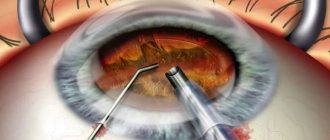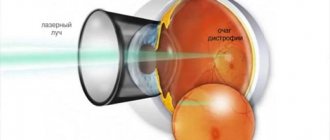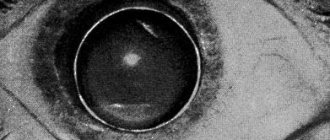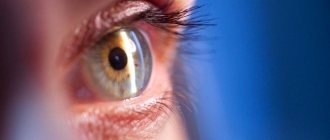Cataract treatment: types of operations
Artificial lens
The most effective method for treating eye pathology is laser removal of the lens. Laser eye treatment allows you to perform surgery with high precision and significantly reduce the recovery period. Laser eye treatment maximizes visual performance and avoids complications such as corneal edema or secondary cataracts.
In addition to the laser technique, cataract treatment can be carried out using extracapsular or intracapsular surgery. Each of these methods has its own advantages and disadvantages, and must be selected individually, taking into account the patient's condition.
Extracapsular extraction involves removing the cloudy lens, but preserving its posterior capsule. Thanks to this, a barrier is established between the anterior ocular segment and the vitreous cavity. The disadvantages of such surgical intervention include the need for sutures.
The intracapsular technique is performed very rarely, as it contributes to the development of ocular trauma due to the large incision. The lens is removed along with the capsule. You can also remove the lens using ultrasound using the phacoemulsification method (the lens is converted into an emulsion using ultrasound and removed).
How should you behave after surgery?
How to behave after cataract surgery? An innovative and modernized technique for surgical intervention in the eyeball requires the patient to remain in bed for a short period of time - only a few hours are allocated for rehabilitation. Even after carrying out the most complex manipulations, including a cornea transplant, rehabilitation takes longer - several days.
In view of this, you need to know how to properly visit the sick, what can be brought to them, and what should be prohibited. Despite the fact that the modernized technique used in surgical intervention makes it possible to minimize the period of rehabilitation and hospitalization, people who require repeated intervention on a certain eye, children, and the elderly require long-term therapy in an inpatient setting of a healthcare facility.
Surgery is the only way to eliminate cataracts
They need the support of their relatives and their help. You should not come to the patient with a noisy company or a crowd of people. This is a prohibited method that leads to fatigue and creates a nervous environment among the patient’s relatives and roommates.
If there is a need to stay in the hospital for a whole day, it is required to leave the ward after a certain time so as not to embarrass patients with your constant presence. Women caring for a sick husband or son should especially take note of this point.
Do not talk a lot and loudly, do not talk about serious illnesses or disastrous outcomes of operations.
The postoperative period passed, and the patient was at home. Now there is no need to visit the hospital. However, special care is required here too. However, it has its own characteristics.
Oddly enough, after surgical intervention in the eyeball area, due attention should be paid to the patient’s nutrition. There are no strict restrictions in this regard
The procedure takes place in the most comfortable environment for the patient.
But for some time it is recommended to refrain from spicy, salty and fatty foods. Abuse of the above foods can provoke the development of gastrointestinal disorders: cause pain, vomiting or other complications, which will definitely affect the healing process of cataracts in the postoperative period.
What complications can occur after cataract surgery?
Despite the fact that this operation is considered one of the safest, it may have its own complications. In most cases, complications arise due to non-compliance with medical recommendations.
- Secondary cataract. It can appear at any time - in a few months, or maybe in a few years. The reason for this is that it is often difficult to remove all the cells of the affected lens.
- Retinal disinsertion
- Increased intraocular pressure. A common cause of this complication is failure to follow recommendations during the rehabilitation period, namely: heavy lifting, excessive physical activity, etc. Sometimes increased intraocular pressure is due to existing diseases and genetic predisposition.
- Displacement of the lens. In most cases, it occurs as a result of an incorrectly performed operation. In this case, repeated surgery is necessary.
- Retinal swelling. Develops as a complication in the presence of concomitant diseases.
- Hemorrhage into the anterior chamber. Appears as a result of medical error or excessive physical exertion. Treatment is carried out with medication; in rare cases, surgery is used.
It is worth noting that discomfort in the eye area after cataract surgery is normal, this is how your body reacts to outside interference. But if you experience severe discomfort, you should consult a doctor.
How to behave after eye cataract surgery (replacing the lens with an IOL)
After cataract surgery with implantation of an artificial lens, the patient remains in the clinic for a short time for postoperative treatment and is then discharged home. It must be remembered that the eye will not be completely healthy for some time. His recovery will take at least 1-1.5 months, during which his visual acuity will gradually improve, that is, this time is necessary for outpatient follow-up treatment. There is no need to worry about the condition of the lens during this period; it has no expiration date and will last a lifetime.
In order for eye recovery to be as effective as possible, the patient should know the following:
What is needed after discharge?
There are not many restrictions and recommendations, but they are:
- Instill drops according to the scheme developed by the doctor.
- On the second day, remove the sterile dressing and do not wear it again.
- In two weeks, make an appointment with an ophthalmologist at your place of residence for an examination.
- Wear sunglasses when going outside.
- Wash your hair and shower only 2 days after surgery.
- Avoid excessive physical activity, avoid overcooling and avoid hot baths for at least 2 weeks.
During treatment, it is necessary to instill into the operated eye the drops prescribed by the surgeon upon discharge. You can do this yourself in front of a mirror, or call your loved ones for help.
How to instill drops and apply ointment?
Before performing the procedure, be sure to wash your hands with soap. Next, while standing, sitting or lying down, it is easy to pull the lower eyelid down and drop 1-2 drops from the inverted bottle into the space between the eye and the eyelid of the operated eye. The eye should be turned upward.
When you need to place ointment or gel in the eye, they are placed behind the eyelid, squeezing out a column of up to 1 cm. After applying the drug, you should blink intensively several times.
What is allowed?
You can watch TV, read books and periodicals, walk in the fresh air, cook, go shopping. If necessary, the ophthalmologist at the clinic should open a “Certificate of Incapacity for Work” and extend it for a period of up to 3-4 weeks. After a month, you can prescribe corrective glasses at any optical shop or ophthalmologist.
General recommendations
Mode. Regular walks in the fresh air are needed. You don’t have to change your diet, just eliminate alcohol. For sleeping, it is better to choose a position on your back or on your side, but opposite the operated eye. These recommendations are especially relevant in the first two weeks of the postoperative period.
Physical activity. In the first week, physical activity should be minimal. After 7-10 days, you are allowed to start doing light gymnastics without bending exercises, strength training, jumping or running. During postoperative treatment, it is necessary to refrain from physical work, bending over or lifting heavy objects. There is no need to make sudden movements or carry loads over 5 kg.
Hygiene. The operated eye should not be touched while washing for 2-3 weeks after the operation and immediately after the procedure; it is recommended to instill disinfectant drops into it. You can start taking a shower 1-3 days after surgery, but not with hot water. After it, it is also necessary to apply a disinfectant solution of eye drops into the eye. It is advisable to visit baths and saunas only after 2 months after the intervention.
Protection for the operated eye. After removing the blindfold on the second day, it is better to go outside wearing dark glasses. They will protect the injured eye from bright sunlight and wind.
Visual stress. It is allowed to watch television programs, go to cinemas, museums, etc., but at the same time, do not forget about the regimen of instilling eye drops and follow it strictly.
After a month, the imposed restrictions will begin to be gradually lifted and after 2 months they will be lifted completely. From this moment, you can return to your normal lifestyle and engage in all activities that were important before the operation.
Visits to the ophthalmologist. Several ophthalmological examinations are necessary in the postoperative period. Their schedule is usually set by the attending physician. Examinations can be carried out both in the clinic and in the ophthalmologist’s office at your place of residence. If spectacle correction is required, it is easier to do it (by ordering glasses) 1-1.5 months after surgery.
Contact professionals and we will save your vision!
Basic rules for rehabilitation after lens replacement
The duration of the rehabilitation period depends on the diligence of the patient himself. If you carefully and carefully follow all the instructions of the ophthalmologist, then the restoration of vision after replacing the lens will be faster and there will be no complications. The main rules that you need to follow:
Compliance with the regime
Bed rest is recommended only on the first day after discharge. The rest of the time it is not required. It is necessary to observe a sleep regime: there should be no lack of sleep, the duration of sleep during the rehabilitation period should be at least 9 - 10 hours. You need to sleep on your back, the pillow should be high. When doing homework, you should not bend or lift heavy objects. Physical overexertion is contraindicated.
Nutrition should be as light as possible in order to reduce energy expenditure on digestion and redirect it to recovery processes. The diet should not contain rough and difficult to digest food. It is advisable to include in the menu: pureed pureed soups, chicken broth, porridge (buckwheat, oatmeal, rice), mashed potatoes, fruits, vegetables. You need foods high in vitamins A, C, E, D: carrots, milk, eggs, rose hips, red bell peppers, avocados, fish, nuts, liver.
Hygiene measures
For the first 2-3 days after lens replacement surgery, it is not recommended to wash your face or hair (to prevent water and detergents from getting into your eyes). In the future, when washing your hair, tilt it back (you cannot tilt it forward). Instead of washing, you can wipe the skin with antiseptic solutions. If water gets into the affected eye, immediately apply antibiotic drops. You cannot put pressure on the eyeball.
It is recommended to wear the postoperative bandage for up to 3-5 days. At home, it should be periodically removed and the eyelids treated with an antiseptic. When going outside, be sure to put the bandage back in place: it will help protect your eye from wind, dust and sunlight.
Using eye drops
Upon discharge from the hospital, the doctor will prescribe medications in the form of drops. These can be: antibacterial, anti-inflammatory and disinfectant drugs. Medicines must be instilled strictly according to the scheme determined by the ophthalmologist. If the rehabilitation of the eye proceeds without complications, then a month after the operation the doctor will reduce the number of instillations, and after some time, cancel them completely.
Medicines are necessary to prevent the development of complications and speed up the healing process of the visual organ. There are certain rules for using eye drops:
- Wash your hands and treat them with antiseptic.
- Open the bottle of medicine.
- Tilt your head back.
- With your free hand, pull your lower eyelid down.
- Look up.
- Bring the bottle to your eye without touching your eyelashes. Squeeze a drop of medicine so that it is halfway between the retracted eyelid and the eyeball.
- Close your eyes to prevent the solution from leaking out of the cavity.
The interval between instillation of different drugs should be at least 10 minutes. Be sure to close the medication bottle tightly after using it. Your attending physician will provide you with an individual regimen for instilling drops into the eye.
How to instill eye drops
General recommendations
- Protect your eyes from mechanical damage.
- During the rehabilitation period (at least 6 months), do not use eye cosmetics (eye shadow, mascara, eyeliner).
- Do not sleep on the operated side for a month.
- Wear sunglasses.
- Don't lean your head forward.
- Do not visit the solarium, swimming pool, sauna, bathhouse for at least a month after the manipulation.
- Do not press on the eye.
- Reading books, watching TV, and working on the computer should be minimal so as not to strain your eyes.
Video: After cataract removal
Lens replacement surgery is safe and painless. Its effectiveness is very high, provided that all rehabilitation rules are strictly followed. These simple commandments will not only help restore your vision, but also improve your quality of life. To avoid the development of long-term complications, visit your doctor once a year for a follow-up examination.
Implantation of an artificial lens: features of the postoperative period
Immediately after the operation, the patient is advised to rest for some time. If you feel very tired from the excitement you have suffered, you can set aside one day for recovery, observing bed rest. The next day, the doctor who performed the operation should assess the patient’s condition and give recommendations, prescribe vitamin supplements that will help restore vision faster.
Restoring vision after lens replacement - features:
- visual load should be moderate, you need to get used to watching TV, reading books (starting with copies with large font);
- for the first two months, it is necessary to limit physical activity, refrain from visiting the sauna, swimming pool, and wear sunglasses to reduce the likelihood of inflammation and infection of the visual organs;
- Acceleration of healing processes is facilitated by taking vitamin complexes such as Vitrum Vision, preparations based on blueberry extract, as well as the use of antibacterial and anti-inflammatory eye drops;
- You need to keep your eyes clean using boiled water, and when carrying out water hygiene procedures, make sure that water, soap, and shampoo do not get into your eyes, wash your hair, tilting it back, carefully controlling the direction of the water.
You can return to your normal lifestyle after replacing the lens in a couple of weeks, but vision will be restored gradually and will return to normal about a month after the operation. A month after cataract surgery, when vision is completely restored, there should be no unpleasant sensations in the eye with a new lens. If you feel constant discomfort, you should contact a specialist for additional examination.
Symptoms
Cataract removal in old age is almost always indicated, since the patient loses the ability to care for himself and perform simple household manipulations. Depending on the stage of development or type of disorder, the symptoms of the disease differ.
Primary cataract
At the initial stage, clouding of the lateral parts of the lens occurs. In this case, visual acuity does not decrease immediately, since light rays pass through the central part unhindered. It is impossible to diagnose the disease at this stage without special equipment, since the lens is slightly changed.
Additionally, the patient notes that he constantly has a desire to rub his eyes with his hands. The initial stage is also characterized by a temporary improvement in vision, when the patient, after deterioration, begins to work without glasses and read small print. However, this period does not last long, after which deterioration occurs again.
Immature cataract
This type of disorder is accompanied by a transition of areas of turbidity from the lateral parts to the central one. The patient notices a significant decrease in visual acuity, flickering before the eyes, and doubling of objects located at a short distance.
When examining the lens, an increase in its size is noted, as well as an increase in the tone of the eye muscles. It becomes cloudy and loses elasticity, light rays pass through with difficulty, and the specialist cannot examine the fundus.
Mature cataract
Removal of cataracts in old age most often occurs when its mature form is diagnosed. In this case, the patient almost completely loses vision and is able to see only the outlines of objects in daylight. At night, the patient sees nothing.
Such manifestations only worsen a person’s psycho-emotional state, since he feels helpless and incapable of performing simple actions. If you look at the lens with a special device, you can see that it has become uniformly cloudy and has a grayish dirty color.
Overmature cataract
When the disease passes to this stage, the patient completely loses vision and is able to see only the sun's rays or the bright light of a flashlight. The lens not only becomes completely and irrevocably cloudy, but its consistency also changes. It becomes less plastic and almost liquid.
In addition, overripe cataracts are in most cases accompanied by glaucoma or iridocyclitis, which aggravates the symptoms. It is worth noting that such changes rarely affect the lens of one eye. Most often, both eyes are involved in the process, but the rate of progression varies.
Features of surgical treatment of cataracts
During cataract surgery, doctors remove the clouded lens, replacing it with a new, artificial one. Surgical intervention is prescribed if other treatment methods have not helped to cope with the pathology. Indications for lens replacement may include abnormalities of its development, dislocations, secondary cataracts or cataracts in late stages.
Cataract surgery - intraocular lenses
Untreated cataracts can lead to vision loss, so they should be diagnosed and treated as soon as possible. If all else fails, the doctor will recommend surgery. It will be selected depending on the patient’s age, as well as the characteristics of the disease.
Cataract surgery
Table. Types of operations.
| View | Information |
| With laser | The most effective and popular technique. The operation is carried out with high precision, is less traumatic than others, and allows for a fairly quick recovery. Postoperative complications develop extremely rarely, but vision improves as much as possible. |
| Intracapsular | An operation that is performed less frequently than other types. With this form of intervention, not only the lens is removed, but also the capsule in which it is located. During the operation, a fairly large incision is made, which severely injures the eyes and prolongs the rehabilitation period. |
| Extracapsular | With this form of surgery, only the affected lens is removed, and a new one is placed in its place, in the capsule. The operation is completed by suturing. |
Laser cataract removal
The operation itself has already been sufficiently mastered and there is no need to be afraid that something will go wrong
However, the postoperative period is a very important time. During the rehabilitation period, you will need to follow a lot of rules and recommendations so that the healing process proceeds as quickly as possible and does not end in complications.
Wear sunglasses after cataract surgery
Wearing an eye patch during the postoperative period
Wearing a bandage is one of the main points after a cataract lens replacement . The postoperative period begins with its use. It performs a protective function, protecting the patient’s eyes from exposure to bright sunlight, ultraviolet rays, and dust particles. As we wrote earlier, you can make such a bandage yourself.
To do this, you only need sterile gauze and adhesive tape. The bandage that is put on the patient in the clinic after the cataract surgery is completed can be removed on the second day, but this gauze bandage will be useful at least during the first week.
Treatment
Cataracts can only be treated with surgery. No pills or drops fight this disease; they only slow down its progression.
Before the operation, you need to undergo a full examination. The ophthalmologist should check the visual acuity and field, degree of opacity and maturity of the cataract. In addition, as mentioned earlier, you will need to donate blood and urine for analysis to determine the presence of inflammatory processes. If any inflammation is detected, you will have to postpone the operation for a while.
Cataract surgery is not difficult for an experienced specialist. The patient does not need to be hospitalized. The operation is performed under local anesthesia and lasts from ten to fifteen minutes. After this, the doctor monitors the patient’s condition for some time, who can return home on the same day.
Phacoemulsification of cataracts
The most effective and popular surgical method for cataract removal is phacoemulsification. The essence of the operation is that a special ultrasound device is inserted into the eye through a small incision. Under its influence, the lens turns into an emulsion and is removed. An artificial lens is inserted into the eye through the same incision. Sutures are not required in this case.
After the operation, a rehabilitation period begins, which is aimed at restoring visual acuity and regenerating eye tissue. It lasts from one month or more. At this time, you need to put special drops into your eyes and follow your doctor’s recommendations. It is worth remembering that drugs can only be prescribed by the attending physician.
During the rehabilitation period there are some restrictions:
- Don't get too cold.
- It is better to avoid visiting a bathhouse or sauna for a while.
- Avoid bending and lifting heavy objects.
- You should protect your eyes from exposure to radiation and mechanical damage.
- Watching TV and reading should be limited in time.
- You should stop smoking and drinking alcohol.
Therefore, after surgery you will need to wear a bandage for some time.
Structure of the lens
Complications
Complications can sometimes occur after lens removal surgery. There may be several reasons for their appearance:
- This is non-compliance with the recommendations of an ophthalmologist.
- Complications can arise due to poor immunity or other characteristics of the body.
- Mistakes during surgery can also lead to serious problems.
Prevention
The main preventive measure is visiting an ophthalmologist at least once a year.
This is especially important for those who spend a lot of time at the computer and experience eye strain. This applies to both diabetics and people suffering from high blood pressure
Phacoemulsification
Physical exercise and walking help reduce intraocular pressure and normalize blood supply to the eyes and optic nerve.
Another method of prevention is a balanced diet. Nutritional deficiency can lead to the development of cachectic cataracts. Therefore, your daily diet should contain as many vegetables, fruits, seafood, cereals and grains as possible. You should avoid overly sweet foods that increase blood sugar levels, such as chocolate, sweet buns, and so on.
When in the sun, you should wear sunglasses with special lenses. This way you can protect the retina from the adverse effects of ultraviolet radiation.
In addition to these primary prevention measures, there are secondary measures:
- Control of fluid intake. You should drink at least a liter of water per day. It is better to give up alcohol and coffee drinks.
- Comfortable clothes. It is unacceptable for clothing collars and ties to put pressure on the neck, thereby impairing blood circulation.
- Compliance with the work and rest regime. Excessive psychological and physical stress should be avoided.
- To give up smoking. This bad habit leads to poor circulation and provokes glaucomatous attacks.
Prevention of cataracts
The existing risks of developing cataracts due to genetic predisposition or due to old age cannot be eliminated. If this is the case, you should limit yourself to regular preventive examinations so as not to miss the onset of the disease.
Patients with diabetes should remember the greater risk of developing cataracts, monitor carbohydrate metabolism and undergo regular examinations by an ophthalmologist.
Other known mechanisms for the development of cataracts - traumatic, chemical, radiation - are those factors that are dangerous not only for the eyes, but also for the entire body as a whole. Any normal person, by default, tries to avoid such influences.
For early diagnosis of cataracts and other eye diseases in adulthood, it is recommended to undergo a preventive examination by an ophthalmologist at least once a year.
Restrictions during the rehabilitation period
Thanks to the use of modern ophthalmological methods for cataract removal, the patient can recover as quickly as possible. During the period of surgical intervention, the patient does not need to undergo subsequent hospital treatment. After the intraocular lens has been inserted into the patient, he remains under the strict supervision of a doctor for several hours. If he does not experience complications, then after this time he can go home.
A person must adhere to the rules until complete recovery. In this case, the lens will take root and visual acuity will be restored. To recover after cataract removal, the patient must:
- Instillation of drops into the eyes prescribed by an ophthalmologist. Most often, after cataract removal, the drug is instilled only into the eye into which the lens was inserted. The most common use of anti-inflammatory and disinfectant traditional medicines. The frequency of administration and the amount of medication used should be determined strictly by a doctor. As the patient recovers, the solution is gradually reduced.
- Control of eye strain in the postoperative period. During this time, the doctor may advise the patient not to overexert himself mentally and physically. In order for vision to fully recover, it is necessary to rest as much as possible. To ensure vision restoration after cataract surgery, it is necessary for a person to sleep for at least 12 hours a day. If the need arises, a person may be prescribed sleeping pills.
- Rehabilitation after cataract surgery requires the patient to be in well-lit rooms only. Only under such conditions is a person allowed to read. When choosing literature, you must ensure that the font is as large as possible. Recommendations after surgery prohibit watching TV or working on a computer during the first period.
- Postoperative behavior requires the patient to strictly follow certain rules. For example, a patient needs to monitor his body postures during the rest period. In the lying position, the stress on the eyes increases significantly. In order to reduce them, you need to sleep on your side. After replacing the lens for cataracts, you need to ensure that the operated eye is on top. The safest body position after cataract surgery is on your back.
- Lifting objects weighing more than 3 kilograms is strictly prohibited. After a certain time, the load can be increased to 5 kilograms.
- After surgery, wearing contact lenses is strictly prohibited.
The patient must undergo rehabilitation in strict accordance with the doctor’s recommendations, which will restore vision in the shortest possible time.
Useful video
Brief answers from practicing physician I.S. Tkach about the postoperative period after cataract removal: general information, use of eye drops, restrictions, glasses and lenses, return to work and eye recovery.
Rehabilitation after lens replacement for cataracts, if all specialist recommendations are followed, lasts less than 6 months. This will restore visual acuity and prevent the development of complications, including secondary cataracts.
Author's rating
Author of the article
Alexandrova O.M.
Articles written
2031
about the author
Was the article helpful?
Rate the material on a five-point scale!
( 7 ratings, average: 3.71 out of 5)
If you have any questions or want to share your opinion or experience, write a comment below.
Possible complications
As with any surgical intervention, complications may occur after cataract removal. Such unpleasant consequences are explained by the individual characteristics of a particular organism, non-compliance with medical recommendations, or a doctor’s mistake during the operation.
Experts identify several main types of complications that occur most often:
- Secondary cataract (15 – 40%). The problem develops after the patient has undergone extracapsular cataract extraction, ultrasound or laser phacoemulsification. The risk of such a complication is reduced if doctors used the latest technologies in microsurgery. In addition, the material from which the intraocular lens is made is very important. The complication is eliminated by surgical or laser capsulotomy.
- Increased intraocular pressure (1-4%). This symptom is observed when the eyeball is damaged, due to the patient’s hereditary predisposition or due to excessive strain on the eyes.
- Retinal detachment (0.3 – 5.6%). The nature of the damage is determined by how limited the field of vision is. Most often, the problem occurs in patients with diabetes or myopia. In order to correct the situation, another operation will be required.
- Macular edema (1 – 6%). The macular area may swell after extracapsular extraction. The risk of such a complication after cataract removal increases the presence of diabetes and glaucoma.
- Displacement of the iola (1 – 1.4%). The artificial lens may become dislodged after unskilled actions by the ophthalmologist. Even with a slight displacement, the patient urgently needs to be operated on again.
- Hemorrhage in the anterior chamber of the eye (0.6 – 1.5%). This may be due to improper installation of the lens or heavy loads in the postoperative period. The problem is treated either with medication or repeated surgical intervention.
- Iris loss (0.5 -1%). If specialists performed an operation with a small incision, then such a complication may occur. The problem manifests itself as uneven scarring of the wound, astigmatism, swelling and skin ingrowth. The treatment regimen for the complication depends on the time at which it appeared: if the iris falls out 2 weeks after the operation and the wound is not infected, the doctor will simply apply additional stitches. And if the intervention was carried out a long time ago, then the prolapsed iris is excised.
Immediately after surgery, a person may have pain in the eye, eyebrow, or temple. There is no need to be afraid of this, because this is a normal reaction of the body to eye injury. But to eliminate the risk of complications after replacing the lens of the eye, it is worth telling your doctor about the problem that has arisen. Only strict adherence to the doctor's instructions and the use of eye drops will help prevent the unpleasant consequences of surgery.
Therapeutic actions aimed at ridding the patient of complications must be carried out taking into account the cause of the development of the pathology and the degree of its neglect. Some complications resolve on their own and require only minor correction, while others require surgical intervention.
Consequences
Although eye pain is a normal reaction of the body to cataract surgery, it is best to consult with your doctor to ensure that no complications develop. Lens replacement is associated with the risks of the following adverse events:
- recurrent cataract. According to statistics, it occurs in approximately twenty percent of cases. This is due to the fact that the surgeon cannot completely remove all the cells of the biological lens. Complications may appear after several months or even years;
- Increased intraocular pressure may be the result of medical error. Hereditary factors also play an important role. Ocular hypertension can easily appear in patients who, during the rehabilitation period, engaged in intense physical exercise, which is strictly prohibited;
- retinal detachment can develop due to injury, existing diseases or medical error;
- development of infectious processes;
- lens displacement often occurs when the size of the artificial lens and its supports do not match;
- retinal edema can occur due to non-compliance with the regimen in the postoperative period, injuries, diabetes mellitus and glaucoma;
- hemorrhage in the anterior chamber does not require repeated surgery; it is treated with medication. This complication most often occurs due to the fault of a specialist or due to excessive stress during the recovery period.
Many patients are concerned about why corneal swelling appears after surgery. Experts explain that this is how eye tissue reacts to ultrasound. Drug treatment will help cope with the unpleasant symptom. Immediately after the swelling goes away, the eyes begin to see well.
Surgery may also cause recurrence of cataracts. The specific reasons for the development of this complication are still not fully understood. The development of the disease is based on the proliferation of epithelium on the lens. As a result, the artificial lens becomes cloudy and vision deteriorates. Cataracts can be caused by a medical error or a poorly performed operation. It is possible that the cells of the lens capsule react violently to the implant.
The first signs of this complication may appear several months or even years after surgery. If you notice a deterioration in color sensitivity and blurred vision, be sure to consult a specialist. In the absence of timely help, other unpleasant symptoms appear:
- double vision;
- blurry image boundaries;
- blurred vision;
- distortion of objects;
- the appearance of spots before the eyes;
- vision does not improve even with the use of lenses or glasses.
So, the postoperative period is no less important than replacing the lens. The skill of the surgeon and correct behavior after surgery are the key to successful recovery and restoration of vision. You should not do rash or thoughtless things during rehabilitation. Please be aware of the restrictions and comply with them. Do not lift heavy objects or allow visual overload. Observe work and rest schedules, and also adhere to proper personal hygiene rules.
Restoring the body after cataract removal
Rehabilitation after surgery takes a long time (can last up to six months). Conventionally, it can be divided into three stages:
- The first stage is the most difficult, taking the first week after surgery. During this period, pain and swelling in the eye area may be observed. Such manifestations are a normal response of the body to intervention. During the first week, the patient notices improvement in vision
- The second stage is from the eighth day to the thirtieth. During this period, the quality of vision is not stable. It is necessary not to overload your eyes. You should limit watching TV, reading books, and working on the computer. You may need glasses for this.
- The third stage is the next 4-5 months.
Features of the postoperative period
The postoperative period has its own characteristics. Let's look at them:
- After the operation, a bandage is usually put on, which is not advisable to remove for half a day after the operation. This blindfold protects your eyes from dust, smoke and other aggressive substances, as well as from bright light.
- After removing the bandage, the eyes should be treated with an antiseptic solution (furacillin, chlorhexedine).
- In the first few weeks, you need to put anti-inflammatory drops in your eyes. To prevent secondary infection from occurring.
- During the first week, doctors do not advise leaving the house unless absolutely necessary.
- After the painful sensations in the eyes pass (usually they last three to four days), you can read or watch TV, but still the time for such activities should be limited to a minimum.
What determines the duration of the rehabilitation period?
Patients are often concerned about how long the recovery period will take. And why it lasts longer for some than others. So let's find out what the recovery period depends on.
- First of all, of course, from the patient’s condition before the operation. The rule is simple: the worse the patient’s condition, the longer it will take to recover.
- Also, the rehabilitation period depends on the type of intervention. A big role is played by how exactly your cataract was removed: ultrasound or laser.
What recommendations should you follow?
After replacing the lens, you need to take special care of your condition. General recommendations:
Avoid eye strain This is perhaps the most important rule. Eye strain should be avoided throughout the recovery period. If you wish, you can read a book, watch TV, or work on the computer one or two days after discharge. But if your eyes get tired, you need to stop the load immediately. You should not drive a car for the first month. Since this overloads the eyes and can provoke the development of complications. Maintain a sleep schedule. In the first month, you should not allow yourself to get enough sleep. Experts recommend ten hours of sleep during the postoperative period. There are also restrictions on sleeping position. It is unacceptable to sleep on your stomach and on the side on which the eye was operated on. The best position is lying on your back. Maintain good hygiene
After the intervention, the body’s local defenses are weakened, so you should be especially careful with hygiene procedures. During the first two weeks, doctors advise avoiding the use of cosmetics, as well as getting water, soap suds, and dust into the eyes.
You should wash your hair by tilting it back, not forward. It is recommended to avoid physical activity for the first month. Avoid all types of sports: gym, gymnastics, yoga, horse riding, jumping, swimming. Lifting heavy objects should also be limited; lifting more than three kilograms is not recommended. It is also strictly forbidden to be in a head down position. Excessive physical activity threatens you with serious complications: pressure increases, including intraocular pressure, and the vessels may not be able to withstand it and hemorrhages form. The use of high temperatures is prohibited. This can also lead to the development of eye bleeding. In the first month, it is forbidden to go to the bathhouse, sauna or be under direct sunlight, and you should also postpone going to the solarium. Avoid drinking alcohol and nicotine. They have a detrimental effect on the condition of blood vessels. This is especially true for alcohol; its use should be avoided in the first month. Try to limit smoking to a minimum.
Restrictions
Rehabilitation after eye lens replacement involves following the following recommendations:
- limit visual stress. If possible, do not watch TV or work on the computer;
- in the first days you should not wash your hair;
- during the first week it is worth limiting the amount of liquid consumed;
- It is better not to drive a car for a whole month;
- do not sleep on the side of the operated eye and stomach;
- In the first days, avoid getting tap water into your eyes. Then wash your face without using cosmetic foams and gels;
- in the first two days, wear a fixing bandage on the operated eye;
- limit your stay in smoky, dusty rooms;
- Avoid physical activity for a month;
- do not lift weights exceeding three kilograms;
- refuse to visit public swimming pools, saunas, baths;
- in the diet it is better to limit the consumption of table salt, spices, and animal fats;
- men should avoid electric razors that create vibration during the recovery period;
- do not take hot baths;
- Avoid direct sunlight. Go outside with sunglasses;
- You should stop using decorative cosmetics for a month;
- give up bad habits: smoking, including passive smoking, as well as alcoholism;
- Visit your eye doctor as prescribed.
Alcoholic drinks disrupt blood flow in the vessels, interfering with wound healing











